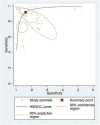Diagnostic accuracy of artificial intelligence for detecting gastrointestinal luminal pathologies: A systematic review and meta-analysis
- PMID: 36405592
- PMCID: PMC9672666
- DOI: 10.3389/fmed.2022.1018937
Diagnostic accuracy of artificial intelligence for detecting gastrointestinal luminal pathologies: A systematic review and meta-analysis
Abstract
Background: Artificial Intelligence (AI) holds considerable promise for diagnostics in the field of gastroenterology. This systematic review and meta-analysis aims to assess the diagnostic accuracy of AI models compared with the gold standard of experts and histopathology for the diagnosis of various gastrointestinal (GI) luminal pathologies including polyps, neoplasms, and inflammatory bowel disease.
Methods: We searched PubMed, CINAHL, Wiley Cochrane Library, and Web of Science electronic databases to identify studies assessing the diagnostic performance of AI models for GI luminal pathologies. We extracted binary diagnostic accuracy data and constructed contingency tables to derive the outcomes of interest: sensitivity and specificity. We performed a meta-analysis and hierarchical summary receiver operating characteristic curves (HSROC). The risk of bias was assessed using Quality Assessment for Diagnostic Accuracy Studies-2 (QUADAS-2) tool. Subgroup analyses were conducted based on the type of GI luminal disease, AI model, reference standard, and type of data used for analysis. This study is registered with PROSPERO (CRD42021288360).
Findings: We included 73 studies, of which 31 were externally validated and provided sufficient information for inclusion in the meta-analysis. The overall sensitivity of AI for detecting GI luminal pathologies was 91.9% (95% CI: 89.0-94.1) and specificity was 91.7% (95% CI: 87.4-94.7). Deep learning models (sensitivity: 89.8%, specificity: 91.9%) and ensemble methods (sensitivity: 95.4%, specificity: 90.9%) were the most commonly used models in the included studies. Majority of studies (n = 56, 76.7%) had a high risk of selection bias while 74% (n = 54) studies were low risk on reference standard and 67% (n = 49) were low risk for flow and timing bias.
Interpretation: The review suggests high sensitivity and specificity of AI models for the detection of GI luminal pathologies. There is a need for large, multi-center trials in both high income countries and low- and middle- income countries to assess the performance of these AI models in real clinical settings and its impact on diagnosis and prognosis.
Systematic review registration: [https://www.crd.york.ac.uk/prospero/display_record.php?RecordID=288360], identifier [CRD42021288360].
Keywords: artificial intelligence; diagnostic accuracy; gastroenterology; pathologies; systematic review.
Copyright © 2022 Parkash, Siddiqui, Jiwani, Rind, Padhani, Rizvi, Hoodbhoy and Das.
Conflict of interest statement
The authors declare that the research was conducted in the absence of any commercial or financial relationships that could be construed as a potential conflict of interest.
Figures





Similar articles
-
Diagnostic Accuracy of Artificial Intelligence Based on Imaging Data for Preoperative Prediction of Microvascular Invasion in Hepatocellular Carcinoma: A Systematic Review and Meta-Analysis.Front Oncol. 2022 Feb 24;12:763842. doi: 10.3389/fonc.2022.763842. eCollection 2022. Front Oncol. 2022. PMID: 35280776 Free PMC article.
-
Machine and Deep Learning for Tuberculosis Detection on Chest X-Rays: Systematic Literature Review.J Med Internet Res. 2023 Jul 3;25:e43154. doi: 10.2196/43154. J Med Internet Res. 2023. PMID: 37399055 Free PMC article.
-
Artificial Intelligence-Assisted Echocardiographic Image-Analysis for the Diagnosis of Fetal Congenital Heart Disease: A Systematic Review and Meta-Analysis.Rev Cardiovasc Med. 2025 Apr 27;26(4):28060. doi: 10.31083/RCM28060. eCollection 2025 Apr. Rev Cardiovasc Med. 2025. PMID: 40351693 Free PMC article.
-
The Accuracy of Artificial Intelligence in the Endoscopic Diagnosis of Early Gastric Cancer: Pooled Analysis Study.J Med Internet Res. 2022 May 16;24(5):e27694. doi: 10.2196/27694. J Med Internet Res. 2022. PMID: 35576561 Free PMC article.
-
Deep learning or radiomics based on CT for predicting the response of gastric cancer to neoadjuvant chemotherapy: a meta-analysis and systematic review.Front Oncol. 2024 Mar 27;14:1363812. doi: 10.3389/fonc.2024.1363812. eCollection 2024. Front Oncol. 2024. PMID: 38601765 Free PMC article.
Cited by
-
Artificial intelligence-assisted capsule endoscopy for detecting lesions in Crohn's disease: a systematic review and meta-analysis.Front Artif Intell. 2025 Apr 1;8:1531362. doi: 10.3389/frai.2025.1531362. eCollection 2025. Front Artif Intell. 2025. PMID: 40235858 Free PMC article. Review.
References
-
- IHME,. Digestive Diseases — Level 2 Cause. (2019). Available online at: https://www.healthdata.org/results/gbd_summaries/2019/digestive-diseases... (accessed June 30, 2022).
-
- Chuks NS. Challenges of Gastrointestinal Endoscopy in Resource-Poor Countries. In: Pascu O. editor. Gastrointestinal Endoscopy. Rijeka: IntechOpen; (2011).
Publication types
LinkOut - more resources
Full Text Sources

